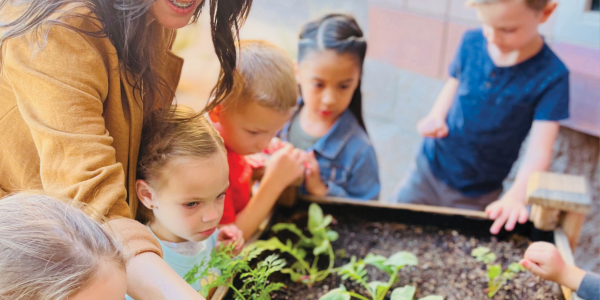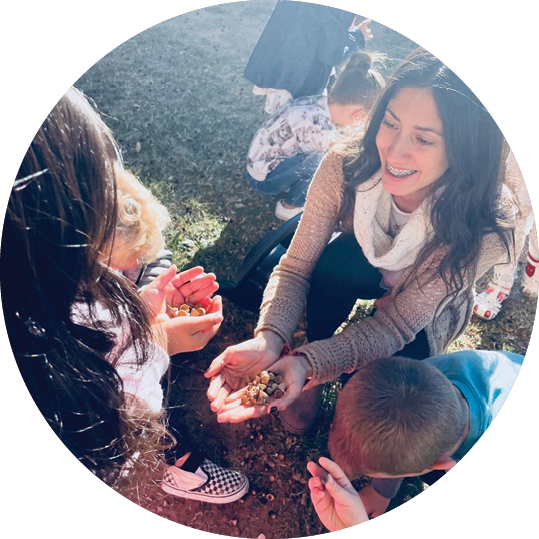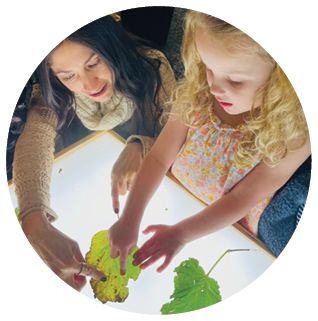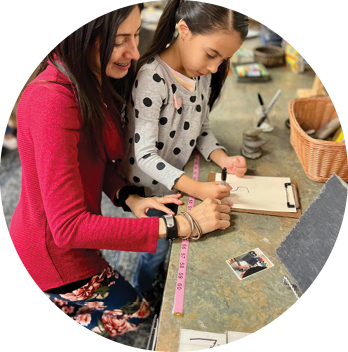Feature Teacher: Marjorie Ruiz

You are here
Marjorie Ruiz teaches in a pre-K setting within the Deer Valley Unified School District in Glendale, Arizona. She has over 11 years of experience in the early childhood field.
Tell us about yourself!
I am from Puerto Rico, born and raised in Aguada, a town on the west coast of the island. I am a collector of memories and a lover of photography, architecture, design, nature, and the arts. My favorite sounds are from nature, especially the sounds of the ocean, which remind me of home. In addition, I love traveling and learning about other cultures and languages.
I see beauty and positivity in everything. I am a creative thinker and avid reader, and I enjoy writing. My family is the most important part of my life. In fact, my interest in early childhood education began with wanting to know more about my children’s learning processes.
How does nutrition and physical activity connect to what you do in your work with young children?
Outdoor environments are as important as indoor ones: they provide children ample space to run, exercise, play, and use fine and gross motor skills. In our classroom, we ensure that children get time outside for well-balanced development.
When it comes to nutrition, we provide a place for gardening where they can learn about the science behind how plants grow. After planting and tending with care and patience, we harvest and eat our vegetables. The children enjoy this process, and at the same time, they are learning how to grow food and eat healthfully. Watching the joy in the children’s faces as they get to see the magic of the seed turning into a plant and then food to eat is very rewarding.
What is something important a child has taught you?
Children have taught me so much through the years, and I continue to learn from them every day. They are capable, curious, and full of life. And the way they see the world is fascinating. One of the many things they have taught me is to see the world with curiosity, adventure, and freshness. They’ve also taught me never to let the child inside of me go away but rather to welcome her, which is a lesson that helps me in both my personal life and professional life.
What strategies would you recommend to build on children’s individual and family strengths, cultural backgrounds, and experiences and to show you value them?
One of the best strategies is to genuinely listen to children and their families without judgment or preconceived thinking and to welcome everyone with an open heart. Coming from a different culture, background, and language, I have found that it is important to understand my own roots in order to truly understand others. To be inclusive to others is essential in valuing them.
One thing I do with the children at the beginning of the year is self-portraits. They look at their features in the mirror and draw what they see. At the end of the process, I ask them, “When you look at yourself in the mirror, how do you see yourself?” or “What do you look like?” Some of my favorite answers are “Like a human,” “Like a person,” “Like myself,” and “Beautiful.” These answers reflect children’s thinking and serve as a reminder to intentionally consider how we treat every child and how we make decisions that impact them.
Describe some ways in which you communicate with families to build and maintain positive and reciprocal relationships.
 We use many ways of communication with our families, including monthly newsletters, QR codes that link to the photo site on our school website, and regularly updating our Twitter accounts. In addition, we foster two-way communication and an open-door policy, encouraging families to tell us more about their cultural background and expectations for their children.
We use many ways of communication with our families, including monthly newsletters, QR codes that link to the photo site on our school website, and regularly updating our Twitter accounts. In addition, we foster two-way communication and an open-door policy, encouraging families to tell us more about their cultural background and expectations for their children.
We also ask families to leave notes and share family pictures for the children at the beginning of the year. We place these pictures in a special area of the room, which helps the children to be at ease because they can always see their family members anytime they miss them. The children enjoy sharing their family photos with each other too. It is always wonderful to watch these moments unfold.
I always encourage families from different cultures to understand the importance of their home language and to encourage them to continue to use it with their children. As the mother of two boys, I made sure my children knew our language and culture from a very young age. From my professional development, I’ve learned about the benefits of multilingualism, and I’ve observed these benefits in my own children’s learning and development.
Share a recent situation in which things didn’t go as planned. What happened, and what did you do to make the most of it for you and the children?
To me, teaching and learning are like the roots of a plant, going in many directions. Children bring their ideas, interests, different points of view, and ways of thinking. I find that when things don’t go as planned, something beautiful usually emerges—if you know how to dance to their music.
 I try to have a mentality of openness, welcoming the unexpected. For example, last year, while watering our class garden, I began asking the children questions. However, many children soon lost attention and started gathering around a tree nearby to collect the hundreds of fallen acorns. I assessed what was happening and observed what the children were truly interested in at that moment. I started to ask different questions from before: “Where do the acorns come from?”, “Why are they all over the ground?”, “What can we do with them?”, “How do they grow?”, and so on. The children were completely engaged, and I embraced the freshness of the moment. We were attuned to nature and researching. Many ideas evolved from that moment, including some we continued exploring in the following weeks.
I try to have a mentality of openness, welcoming the unexpected. For example, last year, while watering our class garden, I began asking the children questions. However, many children soon lost attention and started gathering around a tree nearby to collect the hundreds of fallen acorns. I assessed what was happening and observed what the children were truly interested in at that moment. I started to ask different questions from before: “Where do the acorns come from?”, “Why are they all over the ground?”, “What can we do with them?”, “How do they grow?”, and so on. The children were completely engaged, and I embraced the freshness of the moment. We were attuned to nature and researching. Many ideas evolved from that moment, including some we continued exploring in the following weeks.
What is your favorite children’s book and why?
I have many favorite children’s books. One is Whoever You Are, by Mem Fox. This book about diversity shows that despite the differences of people from around the world, we have the same feelings and are the same under our skin—“Whoever you are, wherever you are, all over the world.” I love how children react to this book and how the simple words carry such a deep message.
Another favorite is The Best Part of Me, by Wendy Ewald, because it is a collaboration of the beautiful words and voices of real children answering what they think are the best parts of their bodies. The book teaches self-appreciation and the beauty of diversity.
What are you reading now?
I have a few books that I am currently reading, both personally and professionally. Professionally, I am reading The Facilitator’s Book of Questions, by David Allen and Tina Blythe. I’m also reading How to Be an Explorer of the World, by Keri Smith, a book about how to explore, observe, and document the world around you. And I am finishing Imagine If . . . Creating a Future for Us All, by Sir Ken Robinson and Kate Robinson.
My personal reading includes Braiding Sweetgrass: Indigenous Wisdom, Scientific Knowledge, and the Teaching of Plants, by Robin Wall Kimmerer, and Calm: Interiors to Nurture, Relax, and Restore, by Sally Denning.
How do you take care of yourself?
I take care of myself by meditating, writing, riding my bike, drawing, painting, laughing, spending time with friends, going on nature walks, and enjoying the simple pleasures of life. Sometimes life can get busy, but I always make sure that I take time to pause, go outside, and be thankful for all the blessings in my life. I try not to let external negativity affect me in any way. Tending my garden, listening to music, and dancing are other ways to take care of myself.
What is your proudest accomplishment as an educator?
My proudest achievement as an educator is when I have inspired others to shift their thinking, their ways of educating, and the language they use toward children. Additionally, when I see that I’ve made a difference for a child and their family says the most beautiful words about my presence in their child’s life, it fills me with joy and pride. Ultimately, I want to ensure I have empowered children, left footprints in their hearts, and shown their capabilities and intelligence to wider communities.
Having an article published in Raising Arizona Kids was another proud moment because the magazine reached a large audience, and the article shone a light on the beauty of listening, being attuned to children, and the importance of the learning process. It also spoke to retaining the freshness of a moment and honoring the incredible potential of children.
I knew I had to teach when . . .
I knew I had to teach when my first child was a toddler. Something shifted in me—the journey to learn about early childhood education began with my desire to understand my own child’s process of learning.
I keep my passion or enthusiasm for teaching alive by . . .
I keep my passion alive by being authentic and disconnecting from preconceived ideas and approaches toward teaching that interrupt the beauty and freedom of learning alongside children. I have a holistic approach—I put my effort and time into documenting, listening, observing, and reflecting on learning and teaching processes.
What is a future professional goal that you have for yourself?
One of the goals I have for myself is to continue making the capabilities of children visible, to have a studio (atelier) where children are welcome to engage, use all their senses, and explore materials to create art and other expressive works. The arts are my favorite language expression because they connect to all of the other disciplines. Also, I would like to write or cowrite a book about journeying into the world of children’s imagination and thinking.
My teaching style is . . .
holistic, emergent, inclusive, and driven by the interests of children. I consider myself a researcher, working alongside children, trying to figure out the world. Education is about exploring and discovering as well as using our minds and senses to engage in our interests so that we can make meaningful connections.
 I also am a believer in simplicity. I have discovered the complexity that lives inside of simplicity if we know how to look at, observe, and listen to children. For example, natural materials found in nature—such as sticks, dried flowers, leaves, and acorns—can seem like simple things, but when a child transforms them into something else or uses them to create art compositions, narratives are born, highlighting the complexity that can come from simple things.
I also am a believer in simplicity. I have discovered the complexity that lives inside of simplicity if we know how to look at, observe, and listen to children. For example, natural materials found in nature—such as sticks, dried flowers, leaves, and acorns—can seem like simple things, but when a child transforms them into something else or uses them to create art compositions, narratives are born, highlighting the complexity that can come from simple things.
One of my favorite quotes is attributed to the Greek philosopher and biographer Plutarch, who said, “The mind is not a vessel to be filled but a fire to be kindled.” I believe that children’s imaginations should be the force that drives the course of learning, so I plan and support experiences that invite children to engage their curiosity and investigate their questions and wonderings. My goal each day is to kindle the fire and uniqueness of every child, make powerful connections, listen to children, be attuned to them, and document the process of their learning and development.
Photographs: courtesy of Tammy Hartsock
Copyright © 2023 by the National Association for the Education of Young Children. See permissions and reprints online at NAEYC.org/resources/permissions.